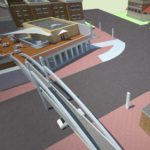Collaboration within and beyond the University
Architecture is collaborative by definition. And so UMA/ARC – students, educators and design professionals – embraces the idea that the communities we live in are part of that collaboration. At UMA Architecture we have put our collaboration with community groups and non-profits at the center of our pedagogy, developing 21 “real project” collaborations over the past few years; most recently seeing some built. By placing our students in these learning situations we give them the tools to create and foster relationships within their own communities.
We Engage Community
Since 2007 we have conducted 36 community-based projects with 22 different community partners. From working with the Augusta-based non-profit Bread of Life Ministries on designing housing for Homeless Veterans, to working with city managers on the master plan of Lewiston’s riverfront, we expose our students to the multiple needs and responsibilities facing today’s architectural designers. Our goal in undertaking this community work is nothing short of giving our students the tools to engage their own communities, and a deep-seated feeling of a responsibility to do so.
To engage community is both our mission and our collective goal. As a smaller, regional institution, our pedagogy and experience is rooted from where we come. We see ourselves as inexplicably linked to the communities that surround us. We want our students, through architecture and other avenues, to fully engage those communities and their own.
We see architecture as collaborative by definition, and we champion the idea that the communities we live in are part of that collaboration. At UMA Architecture our collaboration with community groups and non-profits is at the center of our pedagogy. UMA/ARC aims to educate a new wave of architectural professionals who see their “giving back” as central to their individual practices.

 In the spring of 2008, in anticipation of an addition to Jewett Hall, our 3rd year advanced studio courses undertook the design of the project as part of their curriculum. As the addition was slated to house the Architecture Department of UMA, it seemed relevant to have architecture students study the site, programmatic, and design issues.
In the spring of 2008, in anticipation of an addition to Jewett Hall, our 3rd year advanced studio courses undertook the design of the project as part of their curriculum. As the addition was slated to house the Architecture Department of UMA, it seemed relevant to have architecture students study the site, programmatic, and design issues.
The Department had our students attempt this work for a variety of reasons: to engage them with a “real” project; to engage them with the UMA community they live and learn in; and because as architecture students, they have first hand knowledge of some of the needs of an architecture department’s facilities. In addition, the students were asked to focus on the sustainable aspects of design, specific to this site and project.
In the end, the goal beyond the student work was to use this investigation to broaden the possibilities of the addition. The students, unencumbered by some of the technical issues of design or practice, are readily able to think beyond the proverbial box. These thoughts and explorations were shared in the hopes they would help realize a more successful design solution.

Bread of Life (BoL) Ministries is a non-profit, faith based organization located in Augusta, Maine. They serve the poorest of the poor in the community through a variety of services designed to aid people in developing self-sufficiency. They provide five major services: Soup Kitchen, Homeless Shelter, Transitional Housing, Permanent Housing, and Case Management. Each of these services touches the lives of the elderly, couples, families, single people, veterans, and children that are struggling to meet the basic necessities of life. Bread of Life exists to provide a warm meal, a bed to sleep in and a place to concentrate on feeling like a family and being part of a community.
 In the summer of 2009 Alan Holt, Adjunct Professor of Public Policy at the University of Southern Maine, approached UMA/ARC about working with the East Bayside neighborhood of Portland, Maine. His idea was to build upon work previously done by USM graduate students at the Muskie School of Public Service.
In the summer of 2009 Alan Holt, Adjunct Professor of Public Policy at the University of Southern Maine, approached UMA/ARC about working with the East Bayside neighborhood of Portland, Maine. His idea was to build upon work previously done by USM graduate students at the Muskie School of Public Service.
Here was a chance for our third year students to engage in larger issues and do so with a very real, very active community. East Bayside is a significant and very distinct neighborhood within Portland. This shape of this neighborhood has undergone tremendous physical change over the past 200 years and it is home to the most diverse population in the State. The work of the studio allowed for interaction with real clients and constituencies on a large scale and with many voices.
The project dealt with a multitude of individuals, families, neighborhood organizations, government officials, and a variety of stakeholders. The complexity of the problems was intense. It was the students’ challenge to sort through all of this and help determine a programmatic and architectural vision for this specific area of Portland. Through the work we saw that good design holds great potential answers for resolution.
 The design portion of the East Bayside work focused on the Gateway to Portland and not the entirety of East Bayside. However, the lessons taken from the neighborhood formed the intentional basis for all design work. The specific gateway under consideration will be the Franklin Arterial intersection with Marginal Way, as one enters or exits Highway 295. This location is a nexus of activity, bringing together autos, pedestrians, heavy traffic, a new public trail, issues of Franklin Arterial and its redevelopment, and the East Bayside community. And while this location is not solely representative of East Bayside the work emphasizes this connection, and uses this project’s opportunities to better the East Bayside community.
The design portion of the East Bayside work focused on the Gateway to Portland and not the entirety of East Bayside. However, the lessons taken from the neighborhood formed the intentional basis for all design work. The specific gateway under consideration will be the Franklin Arterial intersection with Marginal Way, as one enters or exits Highway 295. This location is a nexus of activity, bringing together autos, pedestrians, heavy traffic, a new public trail, issues of Franklin Arterial and its redevelopment, and the East Bayside community. And while this location is not solely representative of East Bayside the work emphasizes this connection, and uses this project’s opportunities to better the East Bayside community.
 As part of the Portland Gateway project, groups put forth a proposed program for this area. Questions such as: What potential do certain programs and their mixture create? Housing? Retail? Business? Community spaces? How can we see this area not only as a signature location, but also as the spur to create a better tomorrow? Issues of inhabitation, use, context, relationship to site and region, connection to family, to town, all still play a central part in determining what is “best” for this specific location.
As part of the Portland Gateway project, groups put forth a proposed program for this area. Questions such as: What potential do certain programs and their mixture create? Housing? Retail? Business? Community spaces? How can we see this area not only as a signature location, but also as the spur to create a better tomorrow? Issues of inhabitation, use, context, relationship to site and region, connection to family, to town, all still play a central part in determining what is “best” for this specific location.
 Urban Analysis & Design for Mill Island, Lewiston, ME
Urban Analysis & Design for Mill Island, Lewiston, ME
In the fall of 2009 the senior thesis studio engaged the City of Lewiston, Maine in a master planning exercise. Lewiston is in a very exciting period of growth and transition. Students were given the opportunity to help effect change to a specific underdeveloped portion of Lewiston, an area located near downtown by the old canals once used to power the manufacturing mills.
Students worked in small groups to research, analyze, & design a master plan for this specific area of Lewiston. Upon completion of each group’s master plan, the City selected one master plan as the “most responsive to the City of Lewiston’s issues, needs, and vision.” This selected master plan became the basis for the Architectural work undertaken during spring thesis semester.
In the spring, each student selected an individual architectural project within the master plan. An exciting element of this overall project was the 14 architectural projects all within this studied area of Lewiston. The projects could not help but “speak” to each other. The projects all were well received by Lewiston and its representatives.
 The public library in the Town of Richmond, Maine had been deemed unsafe due to mold, closed, and a temporary library set up nearby although with inadequate space. The Town asked UMA Architecture to study the question of a library design on the existing site. Richmond saw its library as a central piece to its continued revitalization and community building.
The public library in the Town of Richmond, Maine had been deemed unsafe due to mold, closed, and a temporary library set up nearby although with inadequate space. The Town asked UMA Architecture to study the question of a library design on the existing site. Richmond saw its library as a central piece to its continued revitalization and community building.
For the students this project offered them the opportunity to work with real clients through a design process. They undertook program and site analysis to help the town determine the parameters of the library project. Subsequently, each student worked on individual library projects so as to show the town the potential and possibility of their public project. After initial presentations, four students were chosen to share their vision of the library at a town council meeting.

This project asked the students to deal with the human and the spirit; the secular and the sacred; the individual and the community; the specific and the universal; the self and the god. In contemplating any religious space one must attempt to understand not one’s own place in the universe, but rather that of the other. It is of the utmost importance that the designer goes outside him or herself to a more universal and collective point of view. It was the student’s responsibility to move far beyond any sort of preconception toward a conception based in their findings and understandings of the project and people at hand.
The site was the only existing Jewish temple in the Augusta area. Translated, Temple Beth El means “house of God.” And although it may look like a residence, the building was built as a temple in 1957. The site itself lies at the end of a residential street, with close proximity to the Maine State Library and Maine State Capitol Building.
The small size of the existing temple places the community into very direct contact with one another on a regular basis; the limits of the existing architecture demand a closeness and flexibility that may at times be frustrating, but ensures that members remember they are part of a larger whole. In this way, the seeming inadequacy of the building demands and creates community, and this could be lost in any new design. The projects deemed “mort responsive” were shared with the entire congregation.
 UMA/ARC was contacted by Clinton, Maine to help design a veterans memorial to those who both served and those who did not return. The first part of the assignment focused on a precedent study of memorial as a type. This helped the students gain some understanding of memorial design and its place in a given community. The next part of the project had the students working in small groups to design a memorial for a specific site: Clinton’s Old Mill Park – a central public gathering place for many town events and previous site of the town mill. The memorial site is slated to be the starting point for Clinton’s annual Veterans Day parade, ending at the town cemetery.
UMA/ARC was contacted by Clinton, Maine to help design a veterans memorial to those who both served and those who did not return. The first part of the assignment focused on a precedent study of memorial as a type. This helped the students gain some understanding of memorial design and its place in a given community. The next part of the project had the students working in small groups to design a memorial for a specific site: Clinton’s Old Mill Park – a central public gathering place for many town events and previous site of the town mill. The memorial site is slated to be the starting point for Clinton’s annual Veterans Day parade, ending at the town cemetery.
Finally, the students presented their work to the full town council and interested residents. Their projects and presentations were very well received; so much so that the question of a town memorial will be part of the next year’s budget discussions. UMA/ARC plans to stay involved with the hope that the design ideas raised by the students will be part of any final design solution.




From the earliest days of settlement, Hallowell’s history has been linked to the Kennebec River. The site for this project was Hallowell’s historic marine hub. This underused, underdeveloped parcel of riverfront land sits along the Kennebec River at the northern end of town. It acts as a community gathering space for fireworks displays and other events, such as music all summer long, but only by default and not by design.
This project asked students to suggest development for this municipal waterfront lot (MRL), recognizing its history as well as its potential as a multi-modal transportation hub in the central Maine region.
As an edge, the MRL poses some very interesting levels of investigation. It represents the very real edge between land and water. In addition, as it sits toward one end of the business district of Hallowell, it lies at the edge of current commerce. This is at odds with its history, and the town’s connection to the river, which at times has put the waterway very much at the center of town life.
The students spent seven weeks on this project, working in groups and presenting their final design solutions at the Hallowell Town Hall to 200+ community members.



 Urban Analysis & Design for Mill Island, Lewiston, ME
Urban Analysis & Design for Mill Island, Lewiston, ME